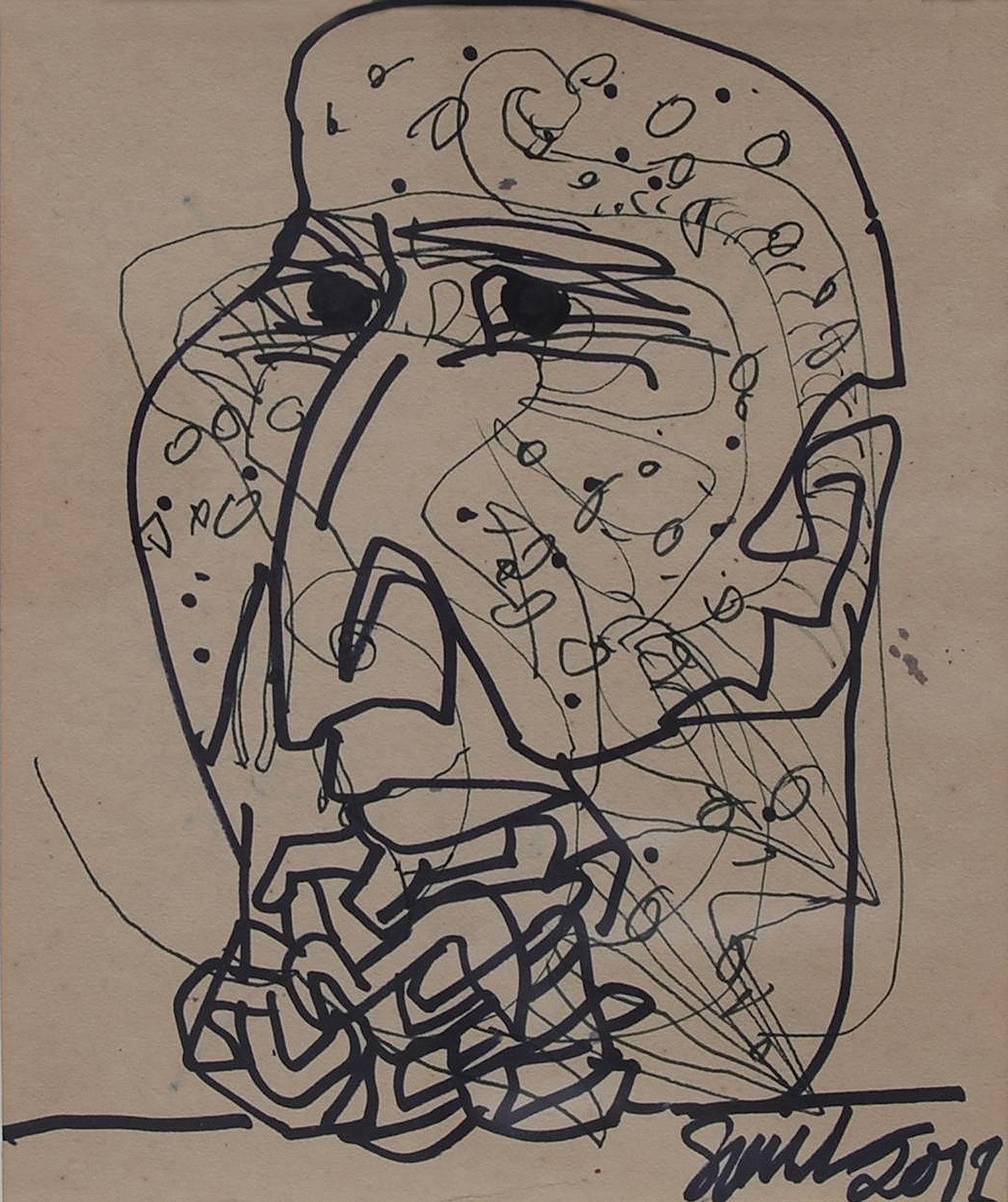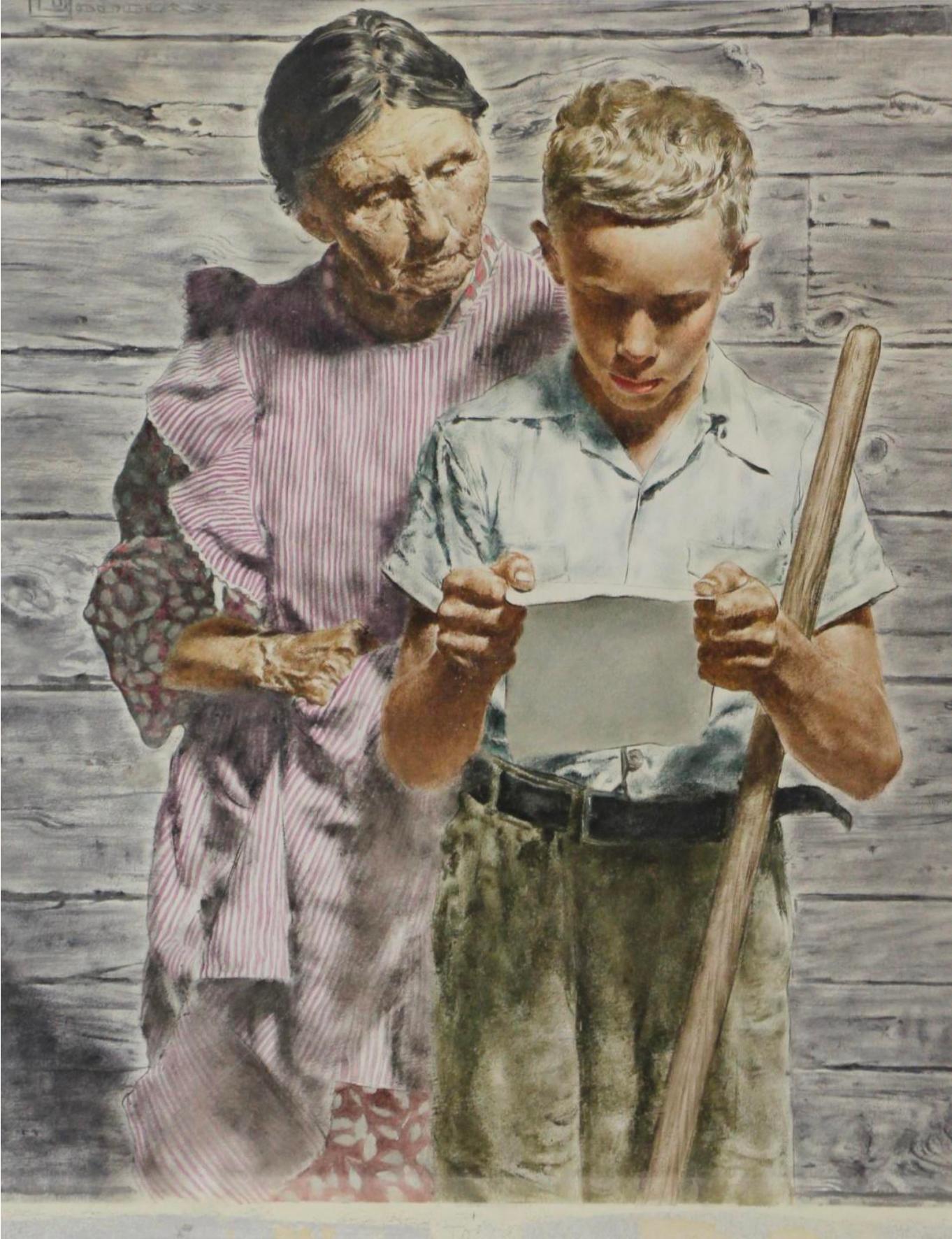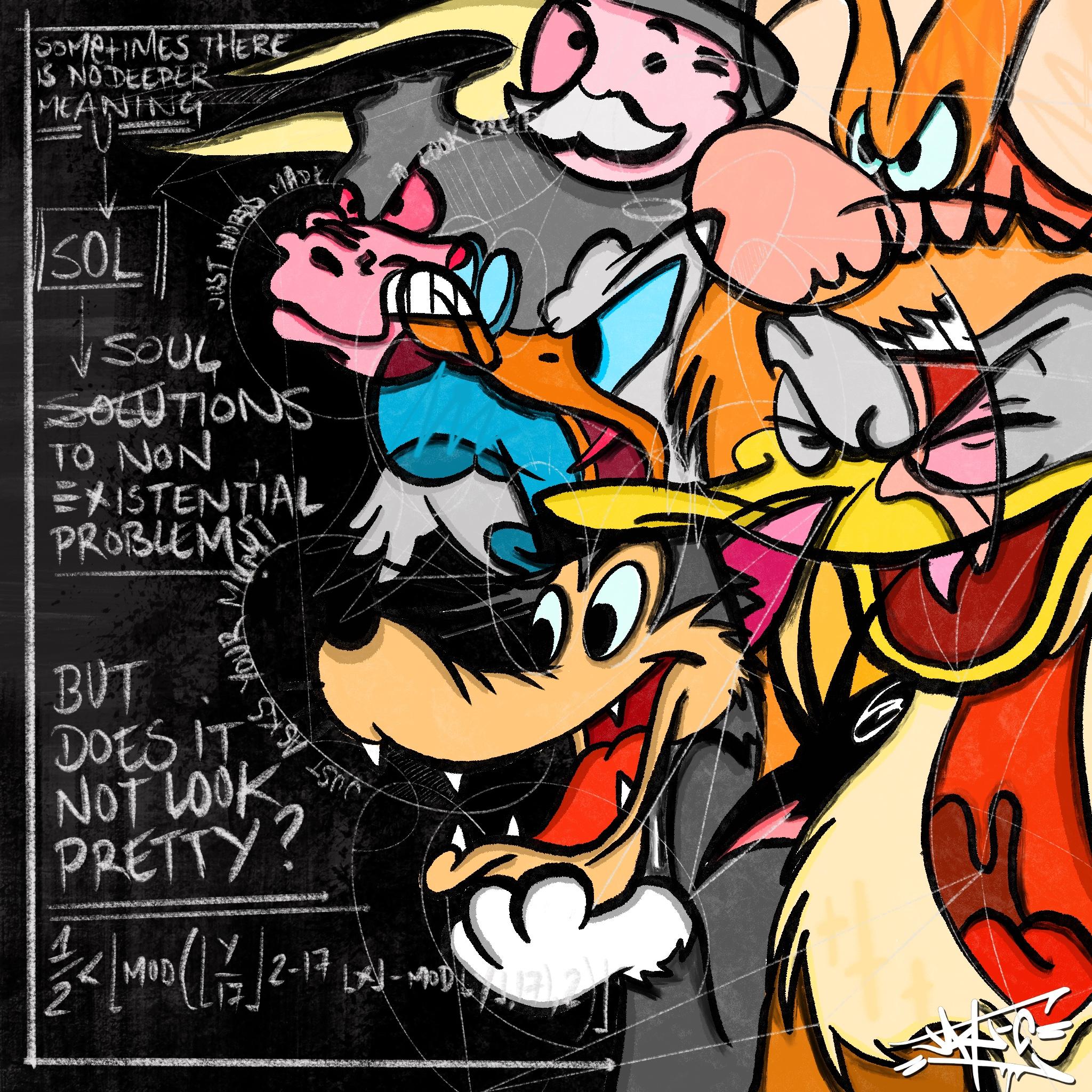Items Similar to The Two Clowns (Les Deux Clowns) by Antonio Gonzalez Collado
Want more images or videos?
Request additional images or videos from the seller
1 of 7
Antonio Gonzalez ColladoThe Two Clowns (Les Deux Clowns) by Antonio Gonzalez Collado20th century
20th century
About the Item
Artist: Antonio Gonzalez Collado
The Two Clowns (Les Deux Clowns)
mixed media on paper
signed
artist studio stamp on the back
dimensions (motif) 15.35 x 11.41 inches (39 x 29 cm)
frame 21.65 x 17.91 inches (55 x 45.5)
Provenance:
A Swedish private collection
- Creator:Antonio Gonzalez Collado (1930, Spanish)
- Creation Year:20th century
- Dimensions:Height: 15.36 in (39 cm)Width: 11.42 in (29 cm)
- Medium:
- Movement & Style:
- Period:
- Condition:Very good condition, ready to hang.
- Gallery Location:Stockholm, SE
- Reference Number:1stDibs: LU1445211298892
About the Seller
5.0
Platinum Seller
These expertly vetted sellers are 1stDibs' most experienced sellers and are rated highest by our customers.
Established in 2020
1stDibs seller since 2020
118 sales on 1stDibs
Typical response time: <1 hour
Associations
International Confederation of Art and Antique Dealers' Associations
- ShippingRetrieving quote...Ships From: Stockholm, Sweden
- Return PolicyA return for this item may be initiated within 2 days of delivery.
More From This SellerView All
- Composition with Reading Girl by an Unknown Artist, Ink on Paper, Dated 1922Located in Stockholm, SEUnknown Swedish Artist Composition with Reading Girl inkl on paper indistinctly signed and dated Eric Eric SON? 1922 frame includedCategory
1920s Figurative Drawings and Watercolors
MaterialsInk, Paper
- "Näspetus" from Zacharias Topelius book series "Reading for Children"Located in Stockholm, SEHere is a delicate ink drawing by the Swedish artist, J.A.G. Acke. Evoking a world of wonder straight from Zacharias Topelius' beloved book series "Reading for Children", this artwor...Category
Early 20th Century Figurative Drawings and Watercolors
MaterialsPaper, Ink
- Portrait of a French Gentleman By Portrait Miniature Artist Daniel SaintBy Daniel SaintLocated in Stockholm, SEDaniel Saint was a prominent French miniaturist who lived between 1778 and 1847. Born in Paris, Saint was the son of a jeweler and initially began his career as an apprentice in his father's workshop. However, he soon discovered his passion for painting and turned his attention to miniatures, which were highly popular in 18th and 19th-century Europe. Saint was a highly skilled artist and quickly gained a reputation for his miniature portraits, which were characterized by their delicate detail and fine brushwork. His works often featured prominent figures from French society, including members of the royal family and high-ranking officials. He also painted portraits of wealthy patrons, many of whom commissioned him to create highly personalized works. Saint's style was highly influenced by the neoclassical movement, which emphasized clarity, simplicity, and rationality. He often used a limited color palette, focusing on soft pastels and muted tones, which helped to accentuate the delicate features of his subjects. His compositions were typically centered around the face, with little background or context to distract from the subject. Despite his success as a miniaturist, Saint was not immune to the changing tastes of the art world. In the mid-19th century, photography began to gain popularity, and many artists who specialized in portraiture found themselves struggling to compete with the speed and accuracy of this new medium. However, Saint continued to work and develop his craft, adapting his style to the changing tastes of his clients and experimenting with new techniques and materials. In addition to his work as a miniaturist, Saint was also a skilled draftsman and created a number of highly detailed and intricate drawings and sketches. He was also known for his use of unconventional materials, such as hair, which he would incorporate into his miniature portraits to add texture and depth. Today, Saint's works are highly prized by collectors and are held in museums and private collections around the world. His legacy as a master of miniature portraiture lives on, and his influence can still be seen in the work of contemporary artists who specialize in this unique and challenging medium. More information: Artist: Daniel Saint (1778-1847) France Title: Portrait of a French Gentleman...Category
Early 19th Century Portrait Drawings and Watercolors
MaterialsGouache
- Postcard Depicting A Farmer With His Three-Pronged PitchforkLocated in Stockholm, SEIsaac Grünewald (1889-1946) Sweden Postcard Depicting A Farmer With His Three-Pronged Pitchfork watercolor on a postcard dimensions: 14 cm x 9 cm (5.51 x 3.54 inches) frame: 22.5 c...Category
1920s Figurative Drawings and Watercolors
MaterialsWatercolor
- On the Sea (På havet, 1911) by Swedish Carl WilhelmsonLocated in Stockholm, SEThe painting På Havet (On the Sea) by Carl Wilhelmson, created in 1911, stands as a remarkable testament to the artist's profound connection with the sea and its influence on his wor...Category
1910s Modern Figurative Paintings
MaterialsWood Panel, Oil
- Ballet Dancer by Jules Schyl, Pastel on paper, Similarities with DegasBy Jules SchylLocated in Stockholm, SEJules Schyl (Sweden, 1893-1977) Title: Ballet Dancers A Ballet Dancer painting is a rare find for an artist mostly known for his oeuvre with Cubism and Expressionist paintings. The current painting has many similarities with Degas sketches...Category
1940s Impressionist Figurative Drawings and Watercolors
MaterialsPaper, Crayon, Pastel
You May Also Like
- Untitled, Mixed Media on Paper, Black, Yellow by Contemporary Artist "In Stock"By Sekhar KarLocated in Kolkata, West BengalSekhar Kar - Untitled, Mixed media on Paper 22 x 28 inches, 2020 (Unframed) ** Free shipping ** Delivered in parcel form mounted but not framed . Style : Sekhar Kar's paintings de...Category
2010s Contemporary Figurative Paintings
MaterialsMixed Media, Paper
- Rare Modernist Hungarian Rabbi Pastel Drawing Gouache Painting Judaica Art DecoBy Hugó ScheiberLocated in Surfside, FLRabbi in the synagogue at prayer wearing tallit and tefillin. Hugó Scheiber (born 29 September 1873 in Budapest – died there 7 March 1950) was a Hungarian modernist painter. Hugo Scheiber was brought from Budapest to Vienna at the age of eight where his father worked as a sign painter for the Prater Theater. At fifteen, he returned with his family to Budapest and began working during the day to help support them and attending painting classes at the School of Design in the evening, where Henrik Papp was one of his teachers. He completed his studies in 1900. His work was at first in a post-Impressionistic style but from 1910 onward showed his increasing interest in German Expressionism and Futurism. This made it of little interest to the conservative Hungarian art establishment. However, in 1915 he met the great Italian avant-gardist Filippo Tommaso Marinetti and the two painters became close friends. Marinetti invited him to join the Futurist Movement. The uniquely modernist style that he developed was, however, closer to German Expressionism than to Futurism and eventually drifted toward an international art deco manner similar to Erté's. In 1919, he and his friend Béla Kádar held an exhibition at the Hevesy Salon in Vienna. It was a great success and at last caused the Budapest Art Museum to acquire some of Scheiber's drawings. Encouraged, Scheiber came back to live in Vienna in 1920. A turning point in Scheiber's career came a year later, when Herwarth Walden, founder of Germany's leading avant-garde periodical, Der Sturm, and of the Sturm Gallery in Berlin, became interested in Scheiber's work. Scheiber moved to Berlin in 1922, and his paintings soon appeared regularly in Walden's magazine and elsewhere. Exhibitions of his work followed in London, Rome, La Paz, and New York. Scheiber's move to Germany coincided with a significant exodus of Hungarian artists to Berlin, including Laszlo Moholy-Nagy and Sandor Bortnyik. There had been a major split in ideology among the Hungarian avant-garde. The Constructivist and leader of the Hungarian avantgarde, Lajos Kassák (painted by Hugó Scheiber in 1930) believed that art should relate to all the needs of contemporary humankind. Thus he refused to compromise the purity of his style to reflect the demands of either the ruling class or socialists and communists. The other camp believed that an artist should be a figurehead for social and political change. The fall out and factions that resulted from this politicisation resulted in most of the Hungarian avant gardists leaving Vienna for Berlin. Hungarian émigrés made up one of the largest minority groups in the German capital and the influx of their painters had a significant effect on Hungarian and international art. Another turning point of Scheiber's career came in 1926, with the New York exhibition of the Société Anonyme, organized by Katherine Dreier. Scheiber and other important avant garde artists from more than twenty-three countries were represented. In 1933, Scheiber was invited by Marinetti to participate in the great meeting of the Futurists held in Rome in late April 1933, Mostra Nazionale d’Arte Futurista where he was received with great enthusiasm. Gradually, the Hungarian artists began to return home, particularly with the rise of Nazism in Germany. Kádar went back from Berlin in about 1932 and Scheiber followed in 1934. He was then at the peak of his powers and had a special flair in depicting café and cabaret life in vivid colors, sturdily abstracted forms and spontaneous brush strokes. Scheiber depicted cosmopolitan modern life using stylized shapes and expressive colors. His preferred subjects were cabaret and street scenes, jazz musicians, flappers, and a series of self-portraits (usually with a cigar). his principal media being gouache and oil. He was a member of the prestigious New Society of Artists (KUT—Képzőművészek Új Társasága)and seems to have weathered Hungary's post–World War II transition to state-communism without difficulty. He continued to be well regarded, eventually even receiving the posthumous honor of having one of his images used for a Russian Soviet postage stamp (see image above). Hugó Scheiber died in Budapest in 1950. Paintings by Hugó Scheiber form part of permanent museum collections in Budapest (Hungarian National Museum), Pecs (Jannus Pannonius Museum), Vienna, New York, Bern and elsewhere. His work has also been shown in many important exhibitions, including: "The Nell Walden Collection," Kunsthaus Zürich (1945) "Collection of the Société Anonyme," Yale University Art Gallery, New Haven, Connecticut (1950) "Hugó Scheiber: A Commemorative Exhibition," Hungarian National Museum, Budapest (1964) "Ungarische Avantgarde," Galleria del Levante, Munich (1971) "Paris-Berlin 1900-1930," Centre Georges Pompidou, Paris (1978) "L’Art en Hongrie, 1905-1920," Musée d’Art et l’Industrie, Saint-Etienne (1980) "Ungarische Avantgarde in der Weimarer Republik," Marburg (1986) "Modernizmus," Eresz & Maklary Gallery, Budapest (2006) "Hugó Scheiber & Béla Kádár," Galerie le Minotaure, Paris and Tel Aviv (2007) Hugó Scheiber's paintings continue to be regularly sold at Sotheby's, Christie's, Gillen's Arts (London), Papillon Gallery (Los Angeles) and other auction houses. He was included in the exhibition The Art Of Modern Hungary 1931 and other exhibitions along with Vilmos Novak Aba, Count Julius Batthyany, Pal Bor, Bela Buky, Denes Csanky, Istvan Csok, Bela Czobel, Peter Di Gabor, Bela Ivanyi Grunwald, Baron Ferenc Hatvany, Lipot Herman, Odon Marffy, C. Pal Molnar...Category
Early 20th Century Modern Figurative Paintings
MaterialsPaper, Charcoal, Pastel, Watercolor, Gouache
- Face, Ink on Paper Black and Brown by PadmaShree Artist Sunil Das "In Stock"By Sunil DasLocated in Kolkata, West BengalSunil Das - 7.25 x 8.5 inches (unframed size) Ink on Paper Inclusive of shipment in ready to hang form. Sunil Das (1939-2015) was a Master Modern Indian Artist from Bengal. Extremel...Category
2010s Modern Figurative Paintings
MaterialsInk, Paper
- Grand Mother and Son Read the LetterBy Robert FunkLocated in Miami, FLMost likely done for the Saturday Evening Post or a major newstand magazine like that Signed upper left FramedCategory
2010s Realist Figurative Paintings
MaterialsOil, Mixed Media
- Existential Problems!, Painting, Pop Art, Street ArtBy Jay-CLocated in Munich, DEEdition 5 JAY-C – the pseudonym of this innovative young artist known for his subversive use of familiar figures and symbols. Using a distinct and fine British sense of humour, he addresses stereotypes of modern society and his work, both playful and profound, stimulates us to question conventional social conceptions. JAY-C is a barometer responding to the world around us. Having had his first solo exhibition in 2018, in the same year he did a collaboration with BoConcept on their iconic Imola chair...Category
2010s Pop Art Portrait Drawings and Watercolors
MaterialsMixed Media, Pigment, Archival Pigment
- Charulata, Conte & Oil on Canvas, Grey Brown white Color , by Master Artist WasimBy Wasim KapoorLocated in Kolkata, West BengalWasim Kapoor - Untitled - 30 x 34 inches ( unframed size ) Oil and Conte on Canvas. . The listed price if for the rolled work . Should you wish to receive it framed the shipping shou...Category
Early 2000s Contemporary Portrait Drawings and Watercolors
MaterialsOil, Canvas, Mixed Media, Conté





